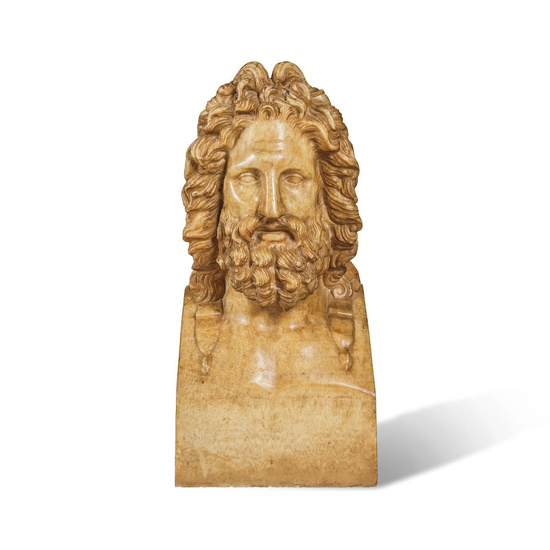Buste en hermès en onyx représentant Jupiter d'Orticoli, Italie, d'après...
Buste en hermès en onyx représentant Jupiter d'Orticoli, Italie, d'après l'Antique, fin du XIXe / début du XXe siècle, restaurations
Carved onyx bust of Jupiter of Orticoli, Italian, after Antiquity, late 19th/early 20th century,
69cm high 27in high).
This impressive marble bust is based on the very famous antique housed in the Vatican Museums in Rome. Known as the Jupiter of Orticoli, it was discovered during excavations funded by Pope Pius VI in 1775 in the town of the same name north of Rome. It immediately became very popular and remains today a very seductive representation of the king of the twelve gods of Olympus, exuding a strong impression of power through the pronounced facial features, thick neck and deeply sculpted leonine hair. All the powers and functions of divinity were embodied in him. He was the god of the sky and of changing weather, whose thunderbolts destroyed his enemies. In Greece, one of the main sites of his cult was the temple of Zeus at Olympia, which contained the famous statue by Phidias, worked in gold and ivory, one of the Seven Wonders of the Ancient World.
Literature
J. Hall, Dictionary of Subjects and Symbols in Art, London, 1996, p. 321
Estimate
Time, Location
Auction House
Buste en hermès en onyx représentant Jupiter d'Orticoli, Italie, d'après l'Antique, fin du XIXe / début du XXe siècle, restaurations
Carved onyx bust of Jupiter of Orticoli, Italian, after Antiquity, late 19th/early 20th century,
69cm high 27in high).
This impressive marble bust is based on the very famous antique housed in the Vatican Museums in Rome. Known as the Jupiter of Orticoli, it was discovered during excavations funded by Pope Pius VI in 1775 in the town of the same name north of Rome. It immediately became very popular and remains today a very seductive representation of the king of the twelve gods of Olympus, exuding a strong impression of power through the pronounced facial features, thick neck and deeply sculpted leonine hair. All the powers and functions of divinity were embodied in him. He was the god of the sky and of changing weather, whose thunderbolts destroyed his enemies. In Greece, one of the main sites of his cult was the temple of Zeus at Olympia, which contained the famous statue by Phidias, worked in gold and ivory, one of the Seven Wonders of the Ancient World.
Literature
J. Hall, Dictionary of Subjects and Symbols in Art, London, 1996, p. 321



